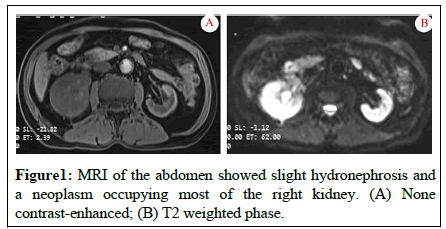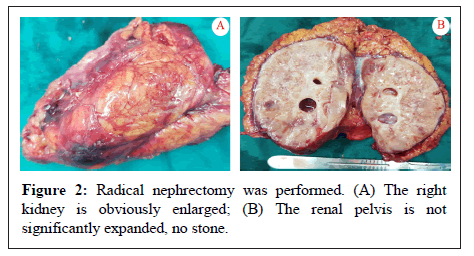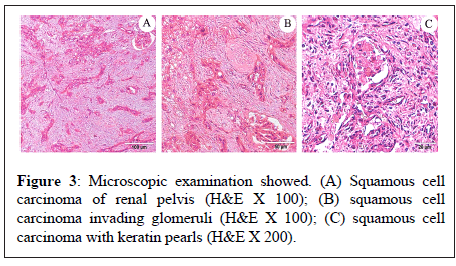A Case Report on Rare Tumour of Renal Squamous Cell Carcinoma and its Associated Risk Factors
Received: 26-May-2023 / Manuscript No. JIDT-23-99794 / Editor assigned: 28-May-2023 / PreQC No. JIDT-23-99794 / Reviewed: 12-Jun-2023 / QC No. JIDT-23-99794 / Revised: 19-Jun-2023 / Manuscript No. JIDT-23-99794 / Accepted Date: 19-Jun-2023 / Published Date: 26-Jun-2023 DOI: 10.4172/2332-0877.1000549
Abstract
Background: Primary renal pelvic SCC is exceedingly rare neoplasm and poor prognosis. We reported a patient who underwent surgery for radical nephrectomy.
Case: The patient was a 72-year old man, who visited doctors with complaints of dull aching in right flank region and occasional gross hematuria. Abdominal contrast-enhanced Magnetic Resonance Imaging (MRI) revealed a neoplasm and hydronephrosis in the right kidney. The preoperative diagnosis of malignant tumor in right kidney was made by urologist, and open radical nephrostomy was performed.
Results: The resected tumor was shown histologically to be squamous cell carcinoma of rightrenal pelvis. Regular monthly follow-up was conducted without chemotherapy or radiotherapy, and patient diedseven months after surgery.
Conclusion: Renal SCC is a rare tumor usually presented in advanced stage with poor prognosis. Early diagnosis and surgical treatment are beneficial for patients’ survival. Renal SCC were associated with risk factors of such as renal calculi and infection, but patient with no risk factors shouldn’t be ignored. We encountered a rare case with no risk factors
Keywords: Squamous cell carcinoma; Renal pelvis; Radical nephrostomy
Introduction
Squamous Cell Carcinoma (SCC) of renal pelvis is a rare neoplasm which accounts only for 0.5%-0.8% of malignant renal tumors [1]. SCC of the upper urinary tracts is usually diagnosed at a later clinical stage, and more invasiveness than other common histologic types. Since renal SCC is usually found in advanced stage and poor prognosis, its mean survival period is 7 months [2]. Renal calculi, infection, endogenous and exogenous chemicals, hormonal imbalance, radiotherapy and vitamin A deficiency are risk factors of renal SCC [3]. But, there were few renal pelvis SCC cases without any risk factors [3,4]. Here we report a patient with SCC lacking these antecedent risk factors, which occurred in the right renal pelvis of a 72-year-old male.
Case Presentation
A 72-year old male patient presented with dull aching in right flank region and occasional gross hematuria for five months. The patient didn’t show history of renal calculi, chronic infections or pyelonephritis. Physical examination revealed percussive pain in the right kidney area, mild tenderness occurred at the right upper ureter point of the patient.
Abdominal Magnetic Resonance Imaging (MRI) of abdomen showed a neoplasm occupying most part of the right kidney and slight hydronephrosis, and without evidence of calculi and vascular invasion (Figures 1A and 1B).
Preoperative examination completed, radical nephrectomy was performed. Tumor was completely resected, the right kidney is enlarged and consolidated, the tumor was fish-like, and without stone in kidney. Microscopic sections were prepared and stained with Hematoxylin and Eosin. Squamous cell carcinoma in right renal pelvis was confirmed by microscopic examination. The patient refused further adjuvant radiation therapy, and he was continuous follow-up monthly. After follow-up for 7 months, the patient died of pulmonary metastasis (Figures 2A and 2B).
Results and Discussion
Squamous Cell Carcinoma (SCC) of the upper urinary tracts is very rare, counting for 10% of all renal pelvic tumors and 0.5% of all renal malignancies [1]. Clinical signs and symptoms in these patients with SCC are obscure, as they often present with vague abdominal pain and gross hematuria. We reported this case with SCC visited doctors because of dull aching in right flank region and occasional gross hematuria, these presents were not specific (Figures 3A-3C).
High invasiveness is a key characteristic of SCC in upper urinary tracts. Compared with other malignancies, SCC of renal pelvis is diagnosed at an advanced stage. To diagnose the SCC, urologists have always faced many difficulties, due to the presentations of SCC is non-specific and locally advanced even metastasis is common. Radical surgical resection is the foremost treatment option, as alternative treatments are of limited efficacy. Despite aggressive surgical efforts, prognosis remains poor as most patients die within one year of surgery. SCC should be suspected in a patient with mass in kidney.
Comparing with other renal malignancies, renal SCC is a more aggressive tumor usually presented in an advanced stage-pT3 or higher, the prognosis is usually poor, as surgical resection is rarely curative and adjuvant radiotherapy is usually ineffective. Prognosis is poor, with a 5-year survival rate of less than 10% [5,6]. The prognosis is poor with a mean survival period of 7 months and five-year survival rate under 10% [2,7]. Symptoms of patients with renal SCC include dull aching flank pain, hematuria, fever, weight loss or with paraneoplastic syndrome [3]. Renal SCC is usually associated with renal calculi and chronic infection, radiological findings such as hydronephrosis, stone, and solid mass are usually not specific for renal SCC [8]. Primary SCC may present as a solid mass with hydronephrosis, calcification, or as an infiltrative renal pelvis lesion without evidence of a significant mass. The radiologic differential diagnosis includes primary and secondary renal tumors and yellow Granulomatous Pyelonephritis (XGP) associated with renal stones [7]. The MRI presentation of renal SCC is rarely described in the literature and, in the few cases mentioned, is found to be nonspecific. A study by Lee et al. found that enhanced extraluminal and exophytic masses, and sometimes intraluminal components, were two of the most useful features of CT imaging of renal SCC. In addition, it is recommended that every patient with kidney stones should undergo regular Intravenous Urography (IVU) screening, especially those with a long history of stones, to check for split function tests in all parts of the renal parenchyma. This recommendation is based on the observation that the presence of filling defects, delayed dye excretion, or parenchymal thickening in the IVU may indicate a renal tumor, despite the absence of a focal mass and preservation of the renal silhouette [5]. In our case, the patient presented with dull pain in right flank pain and hematuria, before surgery SCC did not be suspected. Therefore, IVU was not considered. Diagnosis of renal SCC is difficult before biopsy or surgery and is mostly based on histopathological examination as seen in the present case [2,9]. The main treatment of renal SCC is surgery and patient in low stage may be cured, and adjuvant chemotherapy or radiotherapy is usually given to cases diagnosis in advanced stage but have shown negligible benefit, so early diagnosis is important [10].
Conclusion
We report cases of SCC presenting without any risk factors informing the urologist that the differential diagnosis of SCC cannot be ruled out despite the exclusion of risk factors such as chronic infection, chronic kidney stones, radiotherapy, vitamin A deficiency and analgesic abuse. Renal SCC is a rare tumor usually presented in advanced stage with poor prognosis. Early diagnosis and surgical treatment are beneficial for patients’ survival. Most patients are associated with risk factors of renal SCC such as renal calculi and infection, but patient with no risk factors shouldn’t be ignored. We encountered a rare case with no risk factors.
Consent
Written informed consent was obtained from the patient described.
References
- Li MK, Cheung WL (1987) Squamous cell carcinoma of the renal pelvis. J Urol 138: 269-271.
- Holmäng S, Lele SM, Johansson SL (2007) Squamous cell carcinoma of the renal pelvis and ureter: incidence, symptoms, treatment and outcome. J Urol 178: 51-56.
[Crossref] [Google Scholar] [PubMed]
- Bandyopadhyay R, Biswas S, Nag D, Ghosh AK (2010) Squamous cell carcinoma of the renal pelvis presenting as hydronephrosis. J Cancer Res Ther 6: 537-539.
[Crossref] [Google Scholar] [PubMed]
- Talwar N, Dargan P, Arora MP, Sharma A, Sen AK (2006) Primary squamous cell carcinoma of the renal pelvis masquerading as pyonephrosis: a case report. Indian J Pathol Microbiol 49: 418-420.
[Google Scholar] [PubMed]
- Nachiappan M, Litake MM, Paravatraj VG, Sharma N, Narasimhan A (2016) Squamous cell carcinoma of the renal pelvis, a rare site for a commonly known malignancy. J Clin Diagn Res 10: PD04-PD06.
[Crossref] [Google Scholar] [PubMed]
- Berz D, Rizack T, Weitzen S, Mega A, Renzulli J, et al. (2012) Survival of patients with squamous cell malignancies of the upper urinary tract. Clin Med Insights Oncol 6: 11-18.
[Crossref] [Google Scholar] [PubMed]
- Kalayci OT, Bozdag Z, Sonmezgoz F, Sahin N (2013) Squamous cell carcinoma of the renal pelvis associated with kidney stones: radiologic imaging features with gross and histopathological correlation. J Clin Imaging Sci 3: 14.
[Crossref] [Google Scholar] [PubMed]
- Salehipour M, Dastgheib N, Hosseinzadeh M, Makarem A, Rezvani A, et al. (2019) Primary renal pelvis and ureter squamous cell carcinoma (SCC): a rare case report and review of literature. Int Med Case Rep J 12: 189-192.
[Crossref] [Google Scholar] [PubMed]
- Lin Z, Chng JK, Chong TT, Soo KC (2014) Renal pelvis squamous cell carcinoma with inferior vena cava infiltration: Case report and review of the literature. Int J Surg Case Rep 5: 444-447.
[Crossref] [Google Scholar] [PubMed]
- Jain A, Mittal D, Jindal A, Solanki R, Khatri S, et al. (2011) Incidentally detected squamous cell carcinoma of renal pelvis in patients with staghorn calculi: case series with review of the literature. ISRN Oncol 2011: 620574.
[Crossref] [Google Scholar] [PubMed]
Citation: Chen HC, Ciao W, Zuo MS, He PG, Zhang N (2023) A Case Report on Rare Tumor of Renal Squamous Cell Carcinoma and its Associated Risk Factors. J Infect Dis Ther 11:549. DOI: 10.4172/2332-0877.1000549
Copyright: © 2023 Chen HC, et al. This is an open-access article distributed under the terms of the Creative Commons Attribution License, which permits unrestricted use, distribution, and reproduction in any medium, provided the original author and source are credited.
Share This Article
Recommended Journals
Open Access Journals
Article Tools
Article Usage
- Total views: 972
- [From(publication date): 0-2023 - Jan 31, 2025]
- Breakdown by view type
- HTML page views: 881
- PDF downloads: 91



